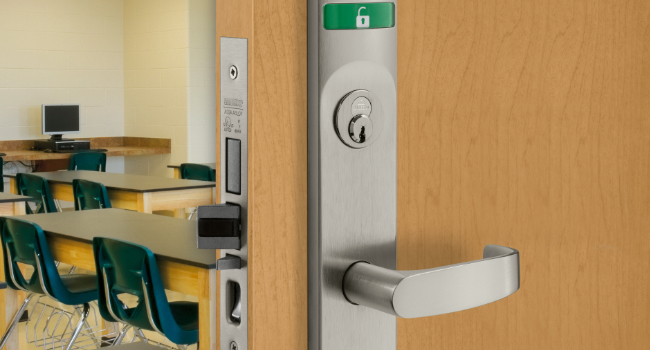
Passing the Test
- By Jeremy Saline
- March 18, 2024
The discussion about secured access and access control for higher education and K-12 is continuously expanding and evolving. That is a good thing. The more knowledge we gain and the more solutions that become available, linked and interoperable, the better and higher the level of security and safety.
The term access control often comes up in the context of doors and locks, but it also applies to perimeter fences, roadway and parking lot gates, screening vestibules, video surveillance, and software and AI for identifying weapons, license plates and restricted visitors. Combined with today’s more sophisticated openings solutions and more comprehensive policies and procedures, these layers help bolster curb-to-core security.
Digital Access
Recent changes for doors and openings include the shift from mechanical to electro-mechanical and networked electronic locks and from the ubiquitous use of brass keys to today’s intelligent, interconnected physical and mobile access control credentials. Facial recognition also is showing greater potential.
Electronic access control (EAC) options have expanded from traditional hardwired to Wi-Fi, real-time wireless, and Power-over-Ethernet (PoE), as well as intelligent key technology. These solutions are far easier to install and more cost-effective to add to a wider range of openings, from campus housing and classrooms to delivery lockers, server cabinets, and many other essential applications.
Even better, the evolution of EAC solutions gives security and facilities personnel the flexibility to immediately issue, modify, and revoke credentials remotely and, in the process, provide a richer, more secure, and seamless user experience. The solutions also generate critical audit trail data for greater accountability, control, and insight.
Migration to Mobile Credentials
More people today want access credentials issued to their phones rather than having to remember and carry a keycard, fob or badge. This is especially true among college students who look for this capability when applying to schools. They expect to be able to use their mobile devices for every transaction, including safe and secure entry to their residence halls and rooms, access to campus dining, fitness, and laundry facilities and admission to school events.
As a result, more colleges and universities have been migrating to mobile credentials in the last few years. Secure delivery lockers in residence halls and centralized mailrooms (including refrigerated units for food orders) are also where mobile credentials fit in perfectly on campus. And since students always have their mobile devices on them and never lose them, the need to reissue credentials is rare.
Credentials in K-12 Environments
At the K-12 level, access control falls under a different set of criteria and perimeters as outlined by the PASS K-12 Safety and Security Guidelines from the Partnership Alliance for Safer Schools (PASS). While many colleges and universities have found it practical to issue EAC cards and mobile credentials to undergraduates, that is not yet a viable option for students in K-12 schools. However, it is realistic for staff and administrators.
There is an argument for an exception regarding digital credentials for students. For instance, when students need to visit the restroom. With an EAC solution, a teacher could issue a credentialed, temporary hall pass card that allows a student to leave the room and the door to automatically relock after it closes. When returning to the classroom, all the student needs to do is present the credential to the door’s card reader to get back in, all with little to no interruption to the teacher and class.
Electronic locks are effective in many other school interior locations as well. To reduce vandalism and theft issues, for example, installing EAC solutions on locker room doors and places like auditoriums, which are periodically occupied and has been proven to deter theft and other unwanted activities that have historically plagued these hard-to-monitor areas. Doors can be programmed to lock and unlock strictly based on scheduled classes like P.E., practices, rehearsals and events in these locations.
Expanding Digital Access Control to More K-12 Openings
Adding EAC to more school exterior entrances and interior openings is a growing trend for many good reasons. Solutions like IN100 Aperio® real-time wireless locks, for example, feature a built-in activation button to initiate a lockdown/shelter-in-place event locally or remotely to instantly alert school personnel and first responders about an emergency.
Then, using pre-issued credentials, law enforcement, and response teams can quickly gain tactical entry through controlled openings during such an event. Certain EAC solutions can also tie into school and district video systems that connect to 911 systems and first responder radios and handheld tablets. This provides greater situational awareness to correlate where police and tactical teams are in relation to openings, perpetrators, and those sheltering in place.
Along with digital solutions, upgrading existing classroom locksets with a simple indicator lock trim can help empower students, teachers and visitors to be a part of the security process and give them peace of mind by being able to immediately know the status of the door.
Technology is highly beneficial and important, but, of course, it is only part of the equation. Safety is everyone’s responsibility. Along with the evolution and adoption of access control solutions, there is the constant need to adapt and improve security measures, policies, and communication to ensure we continue to create safe, comfortable, and conducive learning environments.
This article originally appeared in the March / April 2024 issue of Campus Security Today.